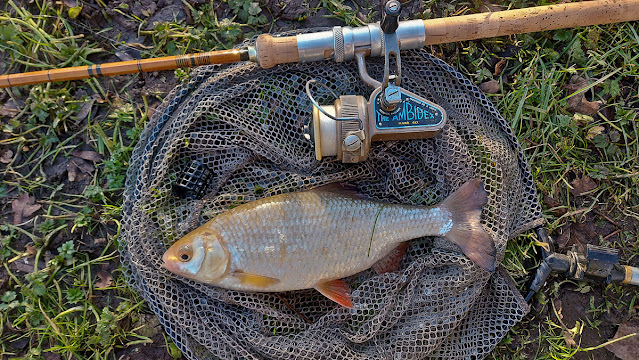BITSA PIECES
The world is awash with unwanted, often but not always unrepairable, cane rods and giving them a new life is very satisfying. I have just finished two, one example was an unwanted 12ft salmon fly rod that I modified to make a ten foot carp rod with a detachable handle, a la Chapman 550. That rod was made for a friend; the second, for myself, is yet another roach rod.
I've collected an enormous pile of scrap cane and fibreglass rods that I can cannibalise to make specials. This one started with a rubbish Sealey Octofloat de luxe. When I bought it, it had a fibreglass tip that didn't fit, a short mid section and a horribly varnished handle.
I have already made a lovely little quivertip rod from an old fly rod. It is ideal for canal fishing with its 1/4 oz tip but it is too light to comfortably cast more than a quarter ounce and I usually use it with 2BB or 2AA pinched directly on the line Fished this way. It has caught me a lot of fish but what I wanted this time was a rod I could use to swing a small feeder up to 25 yds. This would be ideal for roach and bream on the club pool or roach and hybrids from the canal. Small feeders for me are either up to a 15gm cage plus groundbait or blockfeeders up to 20 grams plus maggots.
The top section was just a crappy old bit of non original fibreglass but I managed to find a suitable un-named float rod tip section to replace it. So, stripped and laid out ready for assembly I soon had an Octofloat handle and mid section, a suitable ex-float rod tip and a 2oz fibreglass quivertip. Rings would be low bells suitable for a leger rod, fittings, all Octofloat as a nod to its former life.

For some reason it is not uncommon to find cork handles coated with horrible old varnish. I have tried unsuccessfully to remove it with solvents so this time I put it in the lathe and sanded it off. Measurements taken before and after showed a reduction in diameter of just 0.1- 0.2 mm (between 4 and 8 thou); nothing to worry about really. The incorporated metalwork initially feels quite heavy but is un-noticeable in use as it is beneath the reel and helps balance the rod nicely. An aluminium alloy called Dural or Duralumin was often used to build fibreglass rod handles on. Duralumin was a trade name and no longer seems to exist; I haven't yet been able to find the modern equivalent but I shall use alloy tubes next time especially for float rods where weight is more of an issue.
With the butt section assembled, I could move on to the tip. There was no need to strip the quivertip, I merely shortened the thick end to make rod in two equal sections. A threaded tip ring was drilled out and the quivertip epoxied into it taking great care to align it while setting. The cane having been stripped of rings and varnish was measured up and a new male ferrule made to fit the original female Sealey one.
With all that achieved it was just a matter of whipping the rings on. I used a dark green Kimono silk which is very fine and testing for my geriatric eyesight ( I must get a magnifying headset) but does give a very smooth finish. Unfortunately I made the silly mistake of sealing it with dope rather than PVA and the colour changed virtually black. I should have known better but I'd mis-labelled my test sample nevertheless the finished result was nice enough and does show a green tinge in the sunlight.
The previous rod that I had made had a finer tip and was a much easier fit into the tip ring and I confess that this thicker one did not fit as comfortably. I had to drill a larger hole and it wasn't as neat as I would have liked. In future, I shall make a fine brass ferrule to join them and build a ring onto it. I have in mind to make a heavier version still for river fishing.
Anyway, varnish hardened off it was time for a test run or two and the first chance I would get would be on the Waveney. I had two days fishing with my brother, Colin, to catch something on my new creation and it wasn't long before I was playing catch up. In practice it was too light for this task casting the requisite size of feeder ok but being pulled into such a curve by the current that the tip was effectively useless. Bites were evidenced by the whole rod moving rather than just the tip. I've never understood why a quivertip is necessary if one is going to set it up for bites with it bent right over as Barbel and Tench anglers so often do. It undoubtedly shows a drop back bite well enough, but you don't need a quivertip to do that.
For its second foray I took it to the Ashby canal where it turned out to be every bit as ideal as I had intended it to be for lobbing a 25gm cage feeder three quarters of the way across with breadflake on the hook. I had a couple of little rattles and two beautifully slow pulls round that resulted in a pound and a quarter Bream and a lovely Roach a couple of scales shy of the pound. I set the tip with barely a half inch of tension on it, just enough to show a dropback bite. It handled them every bit as beautifully as one might expect a float rod to do.







Comments
Post a Comment